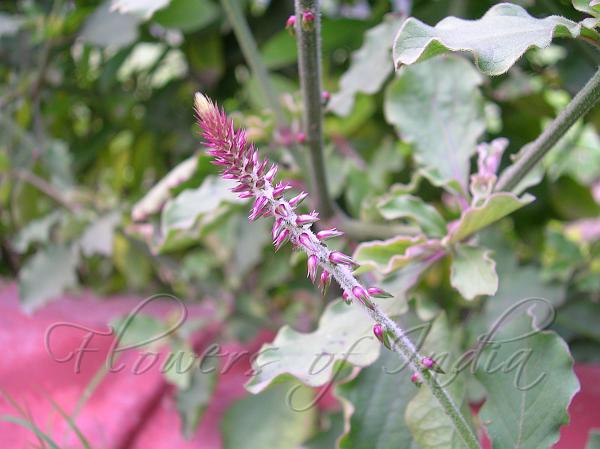|
| Prickly Chaff Flower |
|

|

| File size | 924265 |
| Original date | 2/16/07 2:09 PM |
| Resolution | 2048 x 1536 |
| Flash | Flash did not fire, auto |
| Focal length | 8.0mm |
| Exposure time | 1/40s |
| Aperture | 3.2 |
| Focus Distance | |
| Metering Mode | Partial |
| Camera make | NIKON |
| Camera model | E3700 |
| Sensor type |
|
|
|
Photo: Thingnam Girija |
Botanical name: Achyranthes aspera Family: Amaranthaceae (Amaranth family)
Prickly Chaff-flower is an erect or prostrate, annual or perennial herb,
often with a woody base, which grows as wasteland herb every where. Since
time immemorial, it is in use as folk medicine. It holds a reputed position
as medicinal herb in different systems of medicine in India. Stems 0.4-2 m,
pilose or puberulent. Leaf blades elliptic, ovate, or broadly ovate to
orbiculate, obovate-orbiculate, or broadly rhombate, 1-20 × 2-6 cm,
adpressed-pubescent abaxially and adaxially. Inflorescences to 30 cm;
bracts membranous; bracteoles long-aristate, spinose; wings attached at
sides and base. Flowers: tepals 4 or 5, length 3-7 mm; pseudostaminodes
with margins fimbriate at apex, often with dorsal scale. According to the
Black Yajurveda, Indra, having killed Vritra and other demons was overcome
by Namuchi and made peace with him, promising never to kill him with any
solid or liquid, neither by day or by night. But Indra collected some foam,
which is neither solid nor liquid, and killed Namuchi in the morning
between night and daybreak. From the head of the demon sprung the herb
Apamarga, with the assistance of which Indra was able to kill all demons.
Hence this plant has the reputation of being a powerful talisman, and is
now popularly supposed to act as a safeguard against scorpions and snakes
by paralysing them. Prickly Chaff Flower is found in the Tropical and
sub-Tropical Africa, Asia, Australia, including the Himalayas, till
altitudes of 2300 m.
Medicinal uses: Different parts of the plant are ingredients in
many native prescriptions in combination with more active remedies. In
Western India the juice is applied to relieve toothache. The ashes with
honey are given to relieve cough; the root in dosed of one tola is given at
bedtime for night blindness, and rubbed into a paste with water it is used
as an anjan (eye salve) in opacities of the cornea. The seeds are often
used as a famine food in India, especially in Rajputana, where the plant is
called Bharotha (grass).
Different parts of the plant are ingredients in
many native prescriptions in combination with more active remedies. In
Western India the juice is applied to relieve toothache. The ashes with
honey are given to relieve cough; the root in dosed of one tola is given at
bedtime for night blindness, and rubbed into a paste with water it is used
as an anjan (eye salve) in opacities of the cornea. The seeds are often
used as a famine food in India, especially in Rajputana, where the plant is
called Bharotha (grass).
Medicinal uses:
 Different parts of the plant are ingredients in
many native prescriptions in combination with more active remedies. In
Western India the juice is applied to relieve toothache. The ashes with
honey are given to relieve cough; the root in dosed of one tola is given at
bedtime for night blindness, and rubbed into a paste with water it is used
as an anjan (eye salve) in opacities of the cornea. The seeds are often
used as a famine food in India, especially in Rajputana, where the plant is
called Bharotha (grass).
Different parts of the plant are ingredients in
many native prescriptions in combination with more active remedies. In
Western India the juice is applied to relieve toothache. The ashes with
honey are given to relieve cough; the root in dosed of one tola is given at
bedtime for night blindness, and rubbed into a paste with water it is used
as an anjan (eye salve) in opacities of the cornea. The seeds are often
used as a famine food in India, especially in Rajputana, where the plant is
called Bharotha (grass). | Identification credit: Tabish | Photographed in Jamia Millia Islamia, Delhi. |
• Is this flower misidentified? If yes,